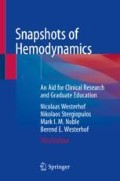Abstract
Resistance to blood flow is an important property of blood vessels. Resistance can be determined by the ratio of mean pressure difference over and mean flow through a blood vessel (R = ΔP/Q, Ohm’s law). For a single uniform vessel Poiseuille’s law can predict its resistance, but in practice we are dealing with a vascular bed consisting of many blood vessels. The resistance although depending on the vascular geometry and (local) blood viscosity, can be calculated directly from measurements of mean pressure difference, ΔP, and mean blood flow, Q using Ohm’s law. Rules for addition of resistances are discussed. Resistance should always be calculated from a mean arterial-venous pressure difference and mean flow both averaged over the entire heartbeat in the steady state. In the systemic circulation venous pressure is usually much lower than aortic pressure and can be omitted. However, this is not the case in the pulmonary circulation. The total vascular resistance is mainly determined by the small arteries and arterioles, often called resistance arteries. This means that the mean pressure in all large, conduit arteries, is almost the same. The arterioles regulate flow to the local tissue.
Access this chapter
Tax calculation will be finalised at checkout
Purchases are for personal use only
References
Vink H, Duling BR. Identification of distinct luminal domains for macromolecules, erythrocytes and leukocytes within mammalian capillaries. Circ Res. 1996;71:581–9.
Driessen GK, Haest CW, Heidtmann H, Kamp D, Schmid-Schönbein H. Effect of reduced red cell “deformability” on flow velocity in capillaries of rat mesentery. Pflugers Arch. 1980;388:75–8.
Feng J, Weinbaum S. Lubrication theory in highly compressible porous media: the mechanics of skiing, from RBCs to humans. J Fluid Mech. 2000;422:281–317.
Zheng J-M, Chin WC, Khijniak E, Khijniak E Jr, Pollack GH. Surfaces and interfacial water: evidence that hydrophilic surfaces have long-range impact. Adv Colloid Interface Sci. 2006;127:19–27.
Christensen KL, Mulvany MJ. Location of resistance arteries. J Vasc Res. 2001;38:1–12. Review.
Hakim TS, Kelly S. Occlusion pressures vs. micropipette pressures in the pulmonary circulation. J Appl Physiol. 1989;67:1277–85.
Spaan JA. Coronary diastolic pressure-flow relation and zero flow pressure explained on the basis of intramyocardial compliance. Circ Res. 1985;56:293–309.
Sipkema P, Westerhof N. Mechanics of a thin walled collapsible microtube. Ann Biomed Eng. 1989;17:203–17.
Schmid-Schönbein H. Critical closing pressure or yield shear stress as the cause of disturbed peripheral circulation? Acta Chir Scand Suppl. 1976;465:10–9.
Sagawa K, Eisner A. Static pressure-flow relation in the total systemic vascular bed of the dog and its modification by the baroreceptor reflex. Circ Res. 1975;36:406–13.
Van Dijk LC, Krams R, Sipkema P, Westerhof N. Changes in coronary pressure-flow relation after transition from blood to Tyrode perfusion. Am J Phys. 1988;255:H476–82.
Sherman IA. Interfacial tension effects in the microvasculature. Microvasc Res. 1981;22:296–307.
Linehan JH, Haworth ST, Nelin LD, Krenz GS, Dawson CA. A simple distensible vessel model for interpreting pulmonary vascular pressure-flow curves. J Appl Physiol. 1992;73:987–94.
Berne RM, Levy MN, Koeppen BM, Stanton BA. Physiology. 5th ed. St. Louis & Baltimore: Mosby-Elsevier; 2003.
Author information
Authors and Affiliations
Rights and permissions
Copyright information
© 2019 Springer International Publishing AG, part of Springer Nature
About this chapter
Cite this chapter
Westerhof, N., Stergiopulos, N., Noble, M.I.M., Westerhof, B.E. (2019). Resistance. In: Snapshots of Hemodynamics. Springer, Cham. https://doi.org/10.1007/978-3-319-91932-4_6
Download citation
DOI: https://doi.org/10.1007/978-3-319-91932-4_6
Published:
Publisher Name: Springer, Cham
Print ISBN: 978-3-319-91931-7
Online ISBN: 978-3-319-91932-4
eBook Packages: MedicineMedicine (R0)

